India’s Cultural Heritage: A Dizzying Mosaic
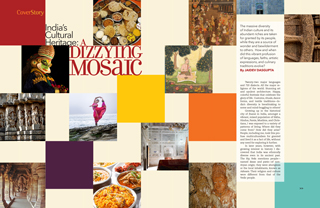
The massive diversity of Indian culture and its abundant riches are taken for granted by its people, while they are a source of wonder and bewilderment to others. How and when did this vibrant profusion of languages, faiths, artistic expressions, and culinary traditions evolve?
Twenty-two major languages and 720 dialects. All the major religions of the world. Stunning art and opulent architecture. Happy, colorful festivals that celebrate the glory of life. Customs, rituals, dance forms, and textile traditions—India’s diversity is breathtaking to some and mind-boggling to others!
Growing up in the historical city of Jhansi in India, amongst a vibrant, mixed population of Sikhs, Hindus, Parsis, Muslims, and Christians, I was exposed to a variety of patterns of living. Where did they come from? How did they arise? People, including me, took this profuse multiculturalism for granted and lived it as a fact of life, without any need for exploring it further.
In later years, however, with growing interest in history I discovered that India was ethnically diverse even in its ancient past. The Rig Veda mentions people—named dasas and panis—of non-Aryan origin; they were aborigines or the local inhabitants, known as Adivasis. Their religion and culture were different from that of the Vedic people.
According to historians, there were social, cultural, religious, and economic variations even in the vast Mauryan empire of King Ashoka, in the 3rd century BCE. Apart from the prominent languages, namely, Sanskrit, Prakrit, Pali, and Tamil, there were perhaps several other local languages spoken in that period. The Upanishads were written in Sanskrit, the Buddha preached in Pali, and the Sangam literature was composed in Tamil.
However, it was roughly between the 7th and 15th centuries that various dynamic and creative forces—political, religious, and cultural—converged to shape the future of the Indian subcontinent. Distinct regions of the land asserted their cultural identities, building the foundation for diversity to flourish as a way of life. During this period, cultural diversification influenced the growth of regionalism. At the political level, while the ambitions of regional kings and their dynasties to establish empires led to division of the land into multiple kingdoms, the backdrop of cultural uniqueness of each region also likely emphasized regionalism. Concurrently, the rulers’ patronage of the arts and architecture helped reinforce local identities.
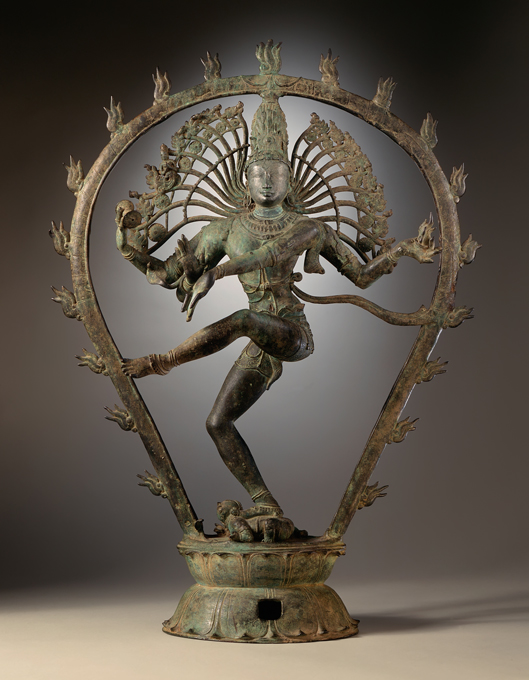
(Left) Shiva (“Nataraja”), as the Lord of Dance, has been revered in the Natyashastra. The variety of art forms that flourished prompted manuals such as Natyashastra (for the classical dances), Kavyadarsha (poetry), Shilpashastras (sculpting), and Vastushastras (Feng shui) that still inform those arts even after centuries. (Photo: LACMA.org)
A cultural flowering
Culture includes everything related to people: customs, traditions, rituals, behavior, knowledge, beliefs, purpose of life, food, morals, religion, law, and so on. And culture expresses itself through various forms—visual art (architecture, sculpture, painting), literature (poetry, writing) and the performing arts (dance, drama, music, singing, etc.), for example. The Sanskrit term for art is kalA. Ancient texts tell us that India had 64 forms of kalA or art, the long list of which includes, in addition to what is mentioned above, flower arrangement, personal grooming, head dressing, gardening, sensual arts, sleight of hand, magic, archery, gymnastics, logic, chemistry, minerology, and more. Essentially, kalA means “the right way of doing something,” and with so many forms of it, virtually every aspect of Indian
life was considered imbued with art. Manuals such as the Natyashastra, Kavyadarsha, Shilpashastras, Vastushastras, and Kamashastras were written, setting down rules and standards for practicing various arts. These richly detailed texts promoted waves of creativity and intellectual activity across the centuries that evolved into the profusely diverse culture that India is known for today.
Rising popularity of literature in regional languages
Two important factors that come to mind when people define their identity, and differentiate themselves from others, are the language they speak and the religious beliefs they hold in common. Though other factors such as food, clothes, and art are also important characteristics of a culture, common language and religion bind people closely to give them a social identity. And as this binding is possible and effective when people live in the same region, the region also becomes another important factor in defining people’s identity—they see themselves hailing from a specific geographic location.
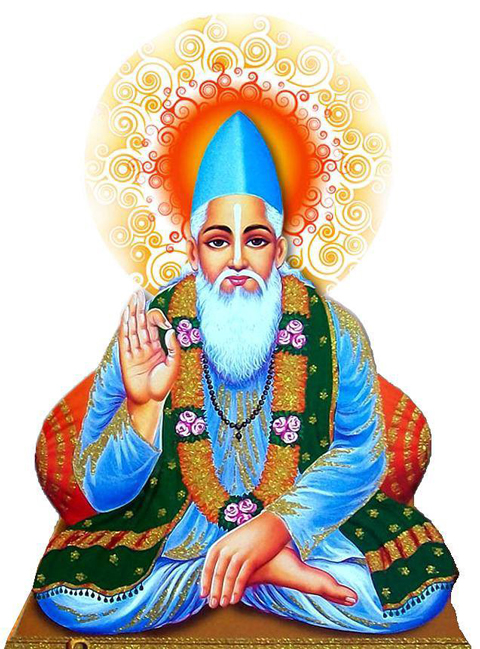
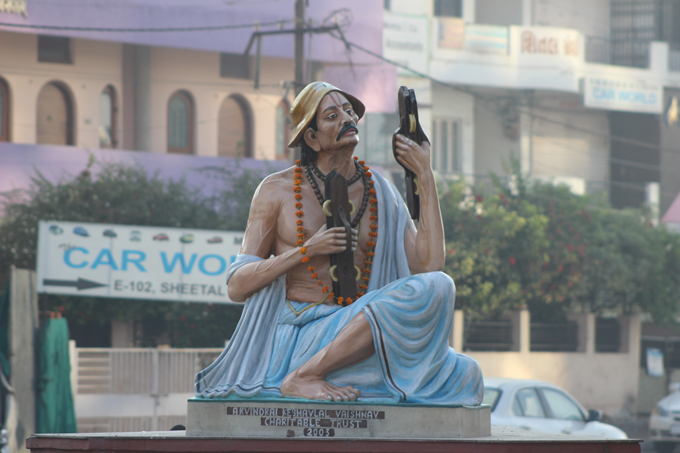
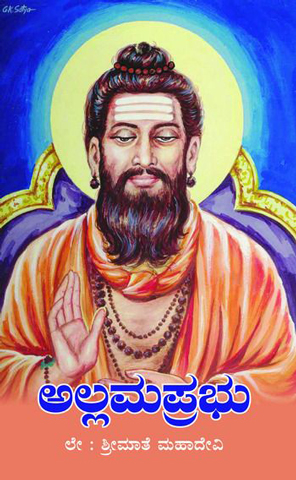
(Far left) Sant Kabir (Photo: Medium.org),
(Left) Narsinh Mehta (a sculpture in present day Vadodara, Gujarat) (Photo: Wiki Commons), and
(Below) Allama Prabhu (Photo: i.pinimg.com)—three of the many luminaries of the bhakti movement.
In ancient India, while the spoken local languages evolved over a long period of time, the adoption of scripts for writing in them spurred the tendency to move away from Sanskrit, the language of the elites. Although Sanskrit maintained its established status with illustrious authors such as Banabhatta, Bhavabhuti, Kalhana, including kings such as Harshavardhana, Someshvar, Krishnadevraj, and Amoghavarsha, from the 9th century onwards, an increasing number of literary works, both religious and secular, started appearing in regional languages such as Kannada, Telugu, Malayalam, Gujarati, Punjabi, Marathi, Bengali and others. The sacred epics—Ramayana and Mahabharata—were translated in these languages. In southern India, the Nayanar and Alvar saints wrote devotional songs, hymns, and poems in Tamil for the deities Shiva and Vishnu. Other poets of this period, hailing from different regions, such as Allama Prabhu, Narsimha Mehta, Jnaneshwar, Baba Farid, Amir Khusrow, Kabir, and Guru Nanak were also mystics and religious leaders.
Religion and philosophy
In the early part of the 7th – 15th century period, the surge in the production of religious literature was due to the rise of the devotional or Bhakti movement. Although Shiva and
Vishnu were worshiped even in earlier centuries, bhakti as a way of developing a personal relationship with
one’s favored deity caught people’s
imagination during this period; it seemed to fulfill people’s spiritual
aspirations. While the movement is seen as a reaction against institutionalized Vedic Brahminism steeped in rituals and
the caste system, it also attracted
people away from the heterodox religions of Buddhism and Jainism. The convergence of Vedic Brahminism, the Bhakti movement, and local cults with beliefs in multiple deities and diverse practices gave rise to Hinduism. It also absorbed Shakti or the Mother Goddess in her various forms as consorts of
Shiva and Vishnu.
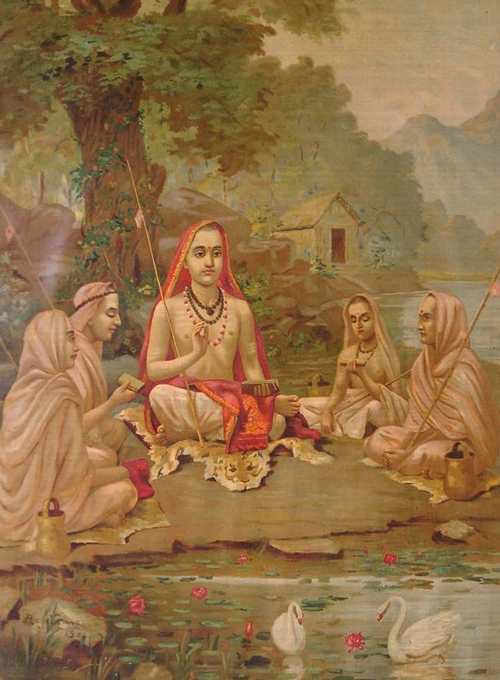
(Left) A painting of Adi Shankaracharya by Raja Ravi Varma, the late 19th century painter whose work is included in the current exhibition "Transcendental Deities" at Emory University's Carlos Museum.
Even as the major religions existed side by side, there were adverse relationships among them, too. Politics played a role in their jostling for dominance. While some kings supported multiple sects, there is evidence that others persecuted Buddhists. The Pala kings of Bengal supported Buddhism. However, it gradually declined, leaving only a small population of Buddhists in India. It is believed that the spread of Vedantic thought—based on the philosophy of Advaita or non-dualism conceptualized by the 8th century theologian-philosopher Adi Shankaracharya—played a significant role in the decline of Buddhism in India.
Furthermore, Ramanuja and Madhava formulated and championed qualified nondualism and dualism, respectively. Other schools of philosophy—Nyaya, Vaisheshika, Samkhya, Yoga, and Mimamsa—were also recognized.
In the 15th century, Sikhism appeared as yet another religion. A few centuries prior to that, Islam had entered north India as a political force, although Christianity, Islam, and Judaism came to South India many centuries before that with merchants and shippers. Thus, by the end of this period, all the major religions of the world were present in India. The subcontinent had absorbed a range of diverse orthodox and heterodox philosophies.
It’s worth noting that a few centuries before the Mughal emperor Akbar propounded Din-i Ilahi—combining elements of different religions, mainly Islam and Hinduism—in 1582 CE, a syncretic tradition, known as Ganga-Jamuni Tehzeeb, developed in the Doab (two rivers) region in the north. It arose from the blending of elements of Hindu and Muslim cultures to promote peaceful and harmonious coexistence of the two communities. The same idea of moving beyond religious differences and focus on common humanity resonated in the preaching of saints such as Nanak and Kabir.
Splendor in stone
Historical texts tell us that it became important for regional kings and large organizations supported by land grants to prominently display their religious affiliations. They funded the erection of massive and spectacular temples. While employing a large number of artisans, sculptors, painters, priests, dancers, musicians, and other workers, the opulence of these temples also spoke eloquently of the image, glory, and wealth of their patrons.
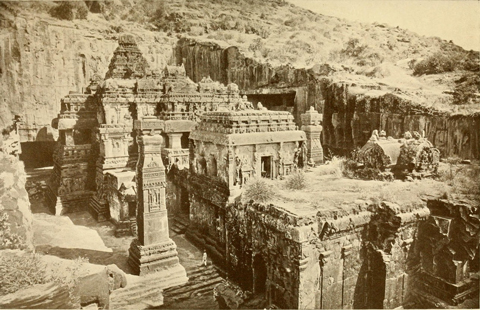
(Left) Kailasa Temple, the largest of the rock-cut temples at the Ellora Caves, Maharashtra. (Photo: Wiki Commons)
Though temples were built according to the rules laid out in the Vastushastra, regional variations flourished in terms of architectural style. There was the Nagar style of the north with a curvilinear tower (shikhar) with amalak (ornamental stone disk) and kalash (metal pot symbolizing creation) on top; the Dravida style of the south with a pyramidal tower (viman), stupika, and kalash; the Vessar, or the blended form found between the Vindhya mountain range and the river Krishna; and the unusual forms found in Kashmir and Bengal. These regional forms had further stylistic differences within themselves. Thus, a range of styles—Chalukya, Chandela, Chola, Hoysala, Kalinga, Kashmiri, Pallava, and Pala—came into existence. While many temples were erected on the ground, others were sculpted out of large rocks (Kailashnath temple of Ellora) and carved in caves (the Ajanta and Ellora caves near Aurangabad and the Elephanta shrines near Mumbai). These buildings were further enhanced with dance rooms, anterooms, space for circumambulation around the deity’s images, secondary deities, assembly halls, and residences for monks.
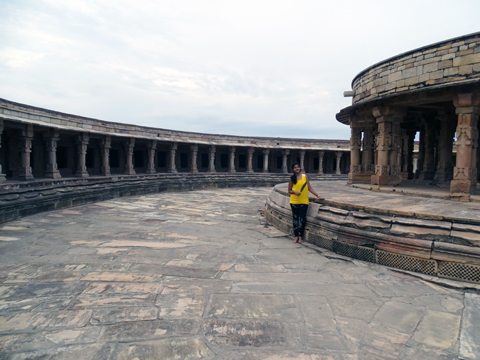
(Left) Chausath Yogini Temple, 10th Century AD, is the abode of Goddess Durga along with 64 yoginis. (Photo: Wiki Commons)
Both inside and outside, these temples and caves were richly decorated with murals and sculptures, reflecting regional styles, with gods and goddesses, scenes from the epics, forms of Devi the Mother Goddess, Shiva’s moods and dances, Vishnu’s ten incarnations, Buddha and Bodhisattvas, Tirthankaras, mythic beings, mythological and Jataka tales, secular life, amorous couples and sensual scenes, dancers and musicians, animal figures, and more.
As the union of the artist’s vision with craftmanship reached its peak in the previous era of the Gupta period that ended in the 6th century, rules for sculptures were canonized in the Shilpashastras, which helped artists fulfill the high demand for large scale production of temple art. New ideas and mediums were explored, giving rise to regional styles and metal works, such as bronze sculptures. These images displayed heavy ornamentation and accentuated body movements. With the large-scale production of art, the focus shifted from symbolism to representation. Some scholars believe that this is when Indian art descended from the divine to the human plane.
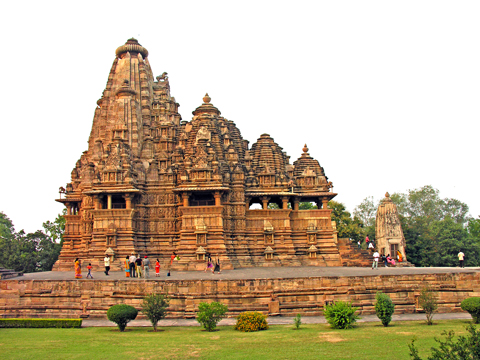
(Right) The Vishvanatha Temple is a part of the Khajuraho Monuments, a UNESCO World Heritage site. (Photo: Wiki Commons).
Certain kings practiced religious tolerance and hence, promoted the building of temples belonging to multiple faiths. Khajuraho, for instance, has Shiva, Vishnu, and Jain temples and the Kapalik tradition (dedicated to Bhairava, a fierce form of Shiva).
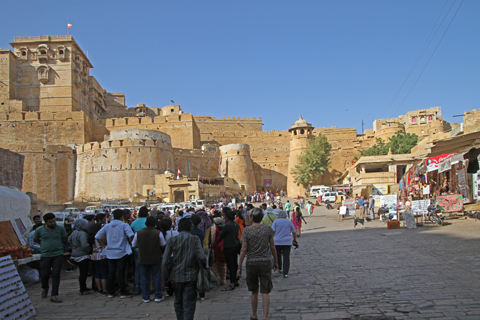
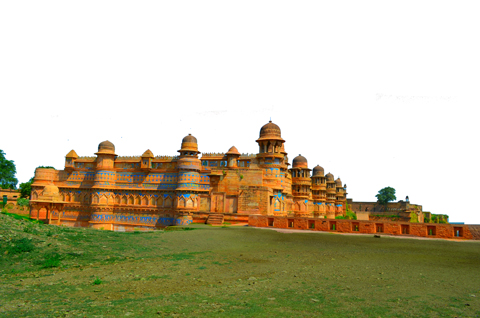
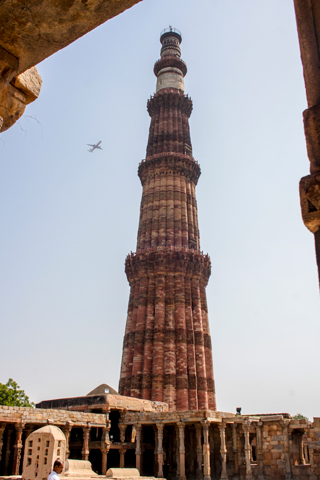
(Above) Jaisalmer Fort (Rajasthan) and Gwalior Fort (Madhaya Pradesh). (Right) Qutub Minar (Delhi). Each dynasty and each region had their own set of architectural nuances and landmarks. (Photos: Wiki Commons).
Architectural creativity also found its expression in the building of spectacular forts such as the 8th century Gwalior Fort in Madhya Pradesh and the 12th century Jaisalmer Fort in Rajasthan.
The arrival of Arabs and Turks introduced new architectural and art forms in India with their emphasis on calligraphy, geometric and abstract patterns, floral and vegetal forms, domes and arches, tiling and tessellation, and so on. Qutub Minar in Delhi and Sufi Shrines in the Multan region are some of the Islamic monuments of this period.
Distinct forms of dance, music, and painting
Dance, drama, and music have been associated with religious rituals since ancient times. Temples, being cultural centers, held dance and music recitals.
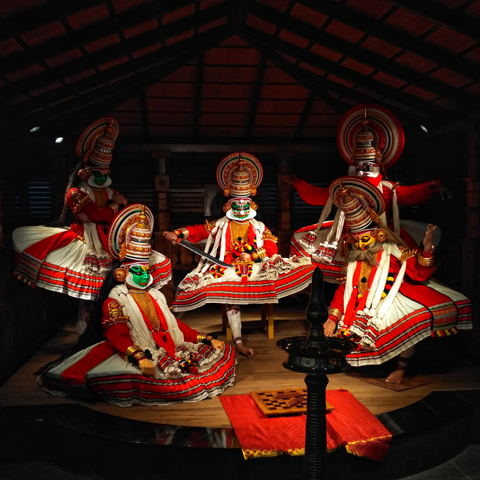
(Right) Kathakali dance (Kerala). (Photo: Wiki Commons)
Now collectively known as the classical dance of India, multiple dance forms—Bharatanatyam, Kathak, Kathakali, Kuchipudi, Odissi, Manipuri, Sattriya, and Mohiniyattam—flourished in different regions. These forms follow the Natyashastra, which codified rules for evoking specific rasas (sentiments) in the audience through the dancer’s portrayal of different bhavas (gestures, postures, and mudras). Essentially, these are dance-dramas in which the dancer uses gestures and movements to act out a story based on Hindu mythology.
Additionally, there were regional folk and tribal dances as well in different socio-economic environments. Unlike the classical dances, folk dances are lively and simple forms, unfettered by codified rules. They are usually performed during festivals and accompanied by folk songs. Some of the tribal dances are also associated with fertility cults. Local variations in both classical and folk dances added to the story of growing regionalism in art and culture.
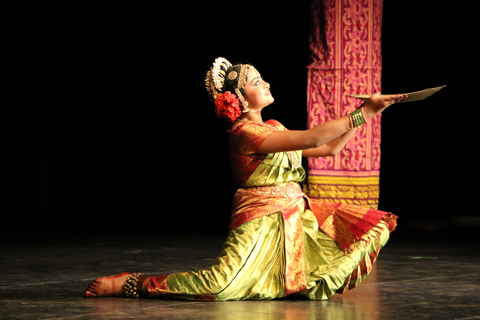
(Left) Kuchipudi originated in Andhra Pradesh. Seen here is dancer Nitya Yelamanchili. (Photo: Wiki Commons)
Along with dance came music, a combination of three arts—recital (vadya), melos (geeta), and dance (nrittya). The Natyashastra, from around the turn of the era (400 BCE-200CE) and ascribed to the sage Bharata, is at the foundation of Indian music and dance. Sangit-Ratnakar, a 13th century treatise by Sarangadeva, discusses swara, tala, raga (note/pitch, beat, melodic pattern), instruments, etc. Various genres of music including Hindustani (from northern India) and Carnatic (from southern India) classical music, khayal, thumri, bhajan, qawwali, ghazal, and others developed in this period. Additionally, different musical instruments came into existence. Alongside, folk music based on themes of love, nature, and philosophy also flourished.
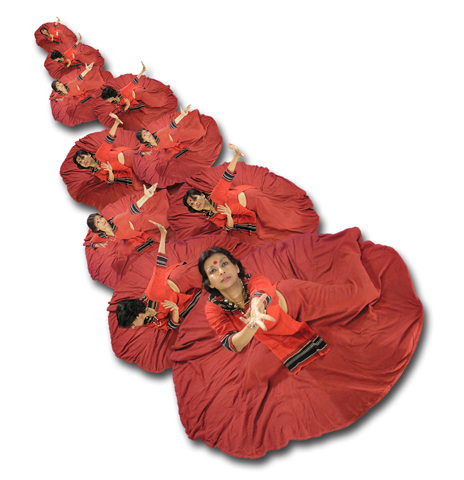
(Left) Mallika Sarabhai, a leading contemporary exponent of the ancient dance form of Bharatnatyam, which originated in Tamil Nadu. (Photo: courtesy, Darpana Academy of Performing Arts)
The temples, besides promoting the performing arts, were also decorated with reliefs, sculptures, and paintings displaying dancers and musicians. Elevated interest in both religious and secular paintings gave rise to distinct regional styles such as the Vijayanagar or Chola paintings. These paintings documented contemporary life including styles of jewelry, headdresses, hairstyles, clothes, and the textile traditions of those times.
Miniature painting was yet another form of art that developed in this era. Apparently, this style of painting started in the 8th century during the Palas rule in eastern India. Its origin, believably, lies in the small images of Buddha painted next to the religious texts on palm leaves. Later, paper was also used. Colors were derived from vegetables, indigo, precious stones, gold, and silver. In the 10th century, this style was introduced in the western part of the country during the Chalukya dynasty. Usually the themes were religious or mythological. Miniature painting reached its zenith during the Moghul era, and new themes were introduced. Subsequently, many schools of miniature painting—Deccan, Jain, Moghul, Odisha, Pala, Pahari, and Rajasthani—flourished, each developing their own styles, color combinations, and themes.
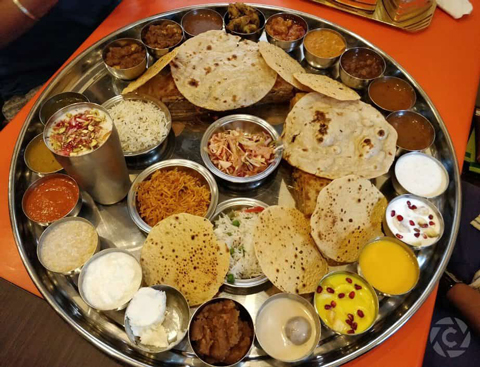
(Right) A typical Gujarati thali (platter) is a generous spread of 3 to 4 shaaks (vegetable entrees), a variety of flatbreads like rotli, thepla, puri, savories like dhokla and khandvi, sweets like mango ras and shrikhand, rice, daals, kadhi, and an array of accompaniments like sweet and spicy chutneys, chaas (buttermilk), papad, pickles, and a lot more.
A culinary smorgasbord
With so much going on during these centuries in terms of religious beliefs, the arts, and architecture, could cuisine be far behind? The huge diversity characteristic of these fields is equally the hallmark of Indian cuisine, which, in itself, is a collection of many regional cuisines that are influenced by cultural traditions and religion. The Jain cuisine, for instance, is completely vegetarian and even excludes using the root vegetables
such as potato, onion and garlic. Furthermore, the food is also classified as sattvic (pure), rajasic (active, passionate), and tamasic (dull, heavy, slow) based on its effect on body and mind.
Regional food traditions obviously started out of locally available vegetables, fruits, grains, pulses, spices, dairy products, meat, and cooking medium. Each region has its distinct favorite dishes, staple food, side dishes, snacks and sweets, level of spiciness, and cooking styles. However, the large network of trade routes and migrations also meant that regional cuisines traveled to other parts, including regions oversees such as Southeast Asia, and influenced the local cuisines. The reverse is equally true; settlers from other parts of the world introduced their own cuisines into the melting pot of Indian culture—for example, Zoroastrians brought the Parsi food. The Portuguese left an undeniable influence on Goan cuisine, too. They also introduced vegetables such as chili peppers, potatoes, and tomatoes.
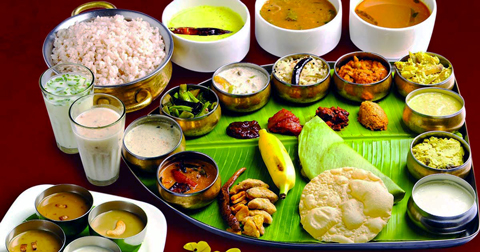
(Left) Kerala cuisine offers spicy coconut-based curries, seafood, a variety of rice dishes, and desserts like cherupayar payasam.
A much bigger and broader enrichment of Indian cuisine occurred with the arrival of Arabs and Moghuls, especially due to their distinctive culinary tradition of nonvegetarian delicacies. Kababs, kormas, biriyanis, pilafs, baked breads, dates and nuts, apricots, melons, peaches and plums, and much more joined India’s vast food platter. An interesting example of how food travels and changes its form is the samosa, a highly popular Indian snack, which travelled a long distance from the Middle East and Central Asia—where it originated around the 10th century and was known by slightly varying names such as Sanbosag, Sanbusak, Sambosa—to India around the 13th century. Amir Khusrow, a scholar and the royal poet of the Delhi Sultanate, is said to have written about royals and nobles enjoying samosa. Though originally it was filled with minced meat, almonds, pistachios, walnuts, and spices, Indians gave samosa a twist by filling it with peas and potatoes.
Thus, what meets the eye as the deeply variegated culture of modern India had its framework laid out between the 7th and 15th centuries, its development powered by rising regional consciousness, intellectual and political dynamism, and the creativity of its people. These forces created a society with a richly diverse culture, which was further enriched as foreign settlers brought their own beliefs, values, traditions, cuisines, and art forms.
Jaidev Dasgupta is the author of In Search of Immortality: An Introduction to Indic World-Views (New Delhi, India: Manohar, 2015). He writes on topics in Indian education, culture, and philosophy. He has been a scientist (M.S. in Physics, Ph.D. in Biology), technologist, and entrepreneur.
Enjoyed reading Khabar magazine? Subscribe to Khabar and get a full digital copy of this Indian-American community magazine.
blog comments powered by Disqus










